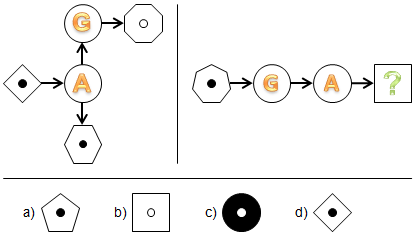What is Diagrammatic Reasoning
Diagrammatic reasoning tests are psychometric assessments constructed of series of flow charts or process diagrams. These tests do not include verbal items and there is no specialised knowledge required in order to attain high score. The below paragraphs will look at these tests in more detail and explain the format, task, what they measure and how your score is evaluated.
Format and task
As the word ‘diagrammatic’ suggests diagrammatic test questions consist of diagrams which are presented with inputs, operators and outputs. Inputs are usually represented as abstract shapes and symbols. Operators are set of rules that change input to the output where output is the final outcome of input. Often, it will be your task to determine the effect each of the operators will have on input in order to produce output. A good example to demonstrate this is indicated in the below diagram.
 |
Note that the letter A changes the shape of the big shape whereas the letter G changes the colour of the small shape. Hence the output must be the answer choice B. Depending on the level of difficulty the number of operators along with inputs and outputs in these tests may vary. It is important to note that there are varieties of tests with different operators. To see further example questions view common diagrammatic reasoning tests.
Why diagrammatic reasoning tests are used
Diagrammatic reasoning tests are frequently incorporated into employee selection. They tend to be specifically administered to candidates applying for jobs in information and technology were high analytical ability is in demand. They are used to measure candidate's mental abilities such as critical thinking or problem solving. A number of studies suggest that diagrammatic reasoning tests provide true reflection of analytical thinking. In other words, they provide clear picture of how clearly and constructively you can think. It is essential to undertake practice tests and make yourself familiar with format prior to taking real assessment.
What diagrammatic test measure
As previously mentioned diagrammatic reasoning assessments measure the extent to which your innate mental processes allow you to manipulate with data flow. These assessments consist of sequence of patters with abstract shapes or symbols which will employ your analytical, critical and reasoning abilities. Research suggests that candidates who tend to understand conceptual processes and are able to manipulate with abstract symbols quickly tend to react faster and take constructive approach to analytical problem solving.
How your score is evaluated
As majority of psychometric tests, diagrammatic reasoning exercises are standardised tests where you score will be compared to score of candidates with similar profile to yours. Hence, employer would not see how many questions you have answered correctly or incorrectly or which questions you haven't answered but rather the test provider would compare your score to score of the norm group where your results would be evaluated in terms of percentiles. That is, you score will show how you have done compared to others. For example if you score on 65th percentile it means that you have done better than 65 percent of population.

